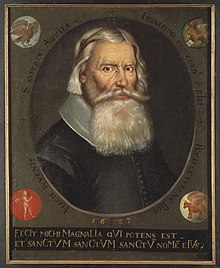Swedish National Heritage Board
[3] On the 20 May that year, Johannes Bureus who was a prominent rune researcher and King Gustavus Adolphus' private teacher, was appointed the first riksantikvarien ("National Antiquarian").Bureus' teachings had made the king interested in ancient monuments and national heritage sites and artifacts, at that time called "antiquities".Together with a priest and a young student, Bureus went on a journey through Sweden to draw and document runestones, collect old coins, chronicles, law books, letter and manuscripts.[5] The Antikvarisk-topografiska arkivet (ATA) ("The Antiquarian-Topographical Archives") and the Royal Swedish Academy of Letters, History and Antiquities' Library are also part of the National Heritage Board.[5] On 2 June 2005, the government decided to relocate a major part of the National Heritage Board's activities from Stockholm to Gotland.[10] The move to Gotland was questioned by several officials within the agency who believed that the government did not understand how the National Heritage Board worked.[15] The National Heritage Board's Gotland Studies (Riksantikvarieämbetets Gotlandsundersökningar) (RAGU), were previously a regional office under the archaeological commission operations during the 1970s to 1980s.[16] The agency run the Internet network Platsr, a site where individuals and organizations can write texts about events and memories connected to local history.



StockholmMinistry of CultureSwedishgovernment agencyWorld Heritage SitesJohannes BureusGustavus Adolphus'runestoneschroniclesJohan HadorphAntiquities ActVatican Citytreasure hunterstumuliSwedish EmpireNational LibraryNational ArchivesRoyal Swedish Academy of Letters, History and AntiquitiesCharles XIV Johnnatural scienceNeoclassicismarchaeological excavationsGotlandSwedish militarySwedish Exhibition AgencyHistory MuseumÖstermalmGamla Uppsala museumGlimmingehusLinköpingGothenburgGotland MuseumCreative CommonsFacebookFlickrexecutiveDirector-generalGeorg StiernhielmOlaus VereliusJohan PeringskiöldJohan Fredrik PeringskiöldBror Emil HildebrandHans HildebrandOscar MonteliusBernhard SalinMargareta BiörnstadNationalencyklopedinSveriges TelevisionSveriges Radio